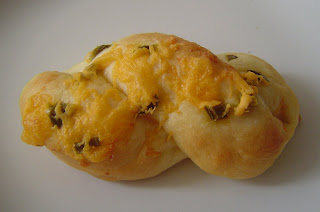 I am sooo happy with this cake!!! I know the picture does not look very good, but you have to make this cake. That is if you like chestnuts. This is a very common cake in Hong Kong. The sponge cake is amazingly light and the chestnut has just the right amount of sweetness, I think the flavor developed after refrigeration because it tasted better the next day. I have been searching for a recipe for this cake because my mom made a special request for this cake. I found a recipe at Eupho cafe and I also found a recipe in an old chinese cookbook I have, called Chopsticks Recipes Cakes and Bread. I adapted things from both recipes and came up with this!!
I am sooo happy with this cake!!! I know the picture does not look very good, but you have to make this cake. That is if you like chestnuts. This is a very common cake in Hong Kong. The sponge cake is amazingly light and the chestnut has just the right amount of sweetness, I think the flavor developed after refrigeration because it tasted better the next day. I have been searching for a recipe for this cake because my mom made a special request for this cake. I found a recipe at Eupho cafe and I also found a recipe in an old chinese cookbook I have, called Chopsticks Recipes Cakes and Bread. I adapted things from both recipes and came up with this!! Chestnut cake
adapted from Chopsticks recipes cakes and bread and Eupho cafe
Chiffon cake:
Four eggs
80g Caster sugar
60ml Vegetable oil
1 tsp vanilla
3 tbsp milk
86g cake flour
2 tbsp cornstarch
1 tsp cream of tartar
- Sift together cake flour and cornstarch.
- Separate egg yolks and egg whites. Using a stand mixer or electric beaters, Beat the egg yolks. While beating the egg yolks, add 40g of the caster sugar. Add sugar in 1 tbsp increments. Beat the egg yolks until it's light and fluffy and the color is a very pale yellow. Once the egg yolks reach that state, mix in the oil, milk and the vanilla. Sift in the cake flour and cornstarch mixture. Gently fold in the flour mixture until just incorporated.
- Preheat oven to 350 F. Add cream of tartar to egg whites and beat with a electric mixer or a stand mixer. Once the egg whites are foamy, add the remaining sugar into the egg whites in 1 tbsp increments. Beat until the egg whites reach soft peaks.
- Gently fold 1/3 of the egg whites until just incorporated. Repeat with the remaining egg whites. Pour the cake mixture into a 8" cake pan (do not grease the pan). Hit pan gently against the counter to remove big bubbles. Bake for 25 to 35 minutes.
- When the cake is finished baking, cool cake upside in the pan. Once the cake is completely cooled, take the cake out of the pan and cut into two equal pieces.
2 cups heavy cream
2 tbsp sugar
2 tsp vanilla
- Beat the cream and sugar in a chilled bowl of an electric mixer at medium speed to soft peaks. Then add the vanilla and continue to beat to barely stiff peaks.
Chestnut filling:
Cooked chestnut 250g
1 1/2 tbsp butter
4 1/2 tbsp caster sugar
- Process cooked chestnut into a food processor until it's fine. Meanwhile, melt butter and sugar together. Poor the butter mixture in the chestnut filling and mix to combine. Once the mixture has cooled, fold in 1/2 cup of the whipped cream.
- To assemble to cake: lay one layer on a cake stand. spread the chestnut filling evenly on the cake. Top with the second layer of the cake and press gently. cover entire cake with the remaining whipped cream and spread the whipped cream evenly to cover the entire cake.








